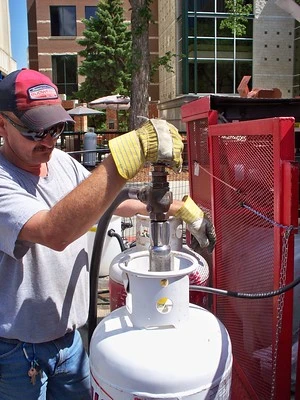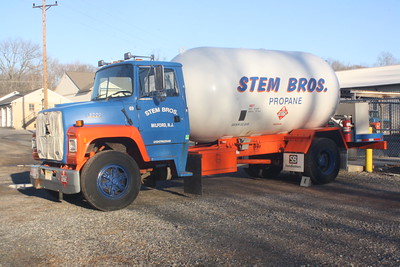
Here are the reasons why propane is used as a refrigerant, with layman-friendly explanations and relevant numbers:
1. Environmentally Friendly:
- Explanation: Propane has a Global Warming Potential (GWP) of just 3. GWP measures how much heat a greenhouse gas traps in the atmosphere compared to carbon dioxide, which has a GWP of 1. Traditional refrigerants like R-134a have a GWP of 1,430, meaning they are much more harmful to the environment. Because propane has such a low GWP, using it as a refrigerant helps reduce the impact on global warming and climate change.
- Example: If you switch to a propane-based refrigerant, you’re significantly cutting down on harmful emissions compared to older refrigerants.
2. Energy Efficiency:
- Explanation: Propane-based refrigeration systems are typically 10-30% more energy-efficient than systems that use older refrigerants. This means they use less electricity to achieve the same level of cooling, which can result in lower energy bills and less strain on power grids.
- Example: If your refrigerator or air conditioner uses propane, it’s likely using less energy to cool your home compared to older models, which can be especially beneficial during hot seasons when electricity demand is high.
3. Widely Available:
- Explanation: Propane is a common and easily accessible fuel. It’s used not only for refrigeration but also for heating, cooking, and more. Because it’s so widely available, it’s often cheaper than specialized synthetic refrigerants, making it a cost-effective choice for cooling systems.
- Example: You can find propane at gas stations, hardware stores, and other outlets, making it convenient to obtain for various uses, including refrigeration.
4. High Performance:
- Explanation: Propane has a boiling point of -42°C (-44°F). In refrigeration systems, the refrigerant needs to evaporate and absorb heat efficiently. Propane’s low boiling point allows it to change from a liquid to a gas at lower temperatures, which is ideal for cooling applications.
- Example: In your refrigerator, propane effectively absorbs heat inside the fridge, keeping your food cold while using less energy.
5. Used in Various Applications:
- Explanation: Propane is versatile and is used in a range of refrigeration systems. In household appliances like refrigerators and freezers, it’s typically used in small quantities (around 150 grams). In commercial settings, such as supermarkets, larger propane systems are employed to cool large spaces efficiently.
- Example: Your home fridge might use propane in a small amount, while a grocery store’s refrigeration units might use larger propane systems to keep all the food products cold.
6. Meets Safety Standards:
- Explanation: Although propane is flammable, its use in refrigeration systems is governed by strict safety standards like EN 378. These standards ensure that systems using propane are designed with safety in mind, including proper ventilation, leak detection, and the use of flame-retardant materials.
- Example: While propane is flammable, when used in a properly designed and maintained system, it’s safe. Modern propane refrigeration systems are built with numerous safety features to prevent accidents.
These points highlight why propane is a popular choice as a refrigerant, balancing performance, cost, and environmental impact.
Read Also: What Time of Year Is Propane the Cheapest? (Summer or Fall)
What Is Propane and How Does It Work as a Refrigerant?
1. Simple Explanation of Propane as a Type of Hydrocarbon Gas:
- Further Explanation: Propane (chemical formula C3H8) is part of a group of gases known as hydrocarbons because it’s made up of hydrogen and carbon atoms. You might be familiar with propane in everyday uses, like fueling your backyard grill or powering heaters. In the world of refrigeration, propane is used for its cooling properties. Unlike some synthetic refrigerants that can harm the environment, propane is a natural gas that doesn’t damage the ozone layer and has a much lower impact on global warming.
2. How Propane Absorbs Heat:
- Further Explanation: In a refrigeration system, the goal is to move heat out of an area (like the inside of your fridge) and release it somewhere else (like outside your home). Propane does this effectively because of its ability to absorb heat as it changes from a liquid to a gas. For example, propane has a boiling point of -42°C (-44°F). When it evaporates, it pulls heat out of the surrounding environment. This process cools the area you want to keep cold. The heat is then carried away by the propane gas and released outside when the gas is compressed back into a liquid.
- Example: Think of it like this: when you sweat, the liquid (sweat) on your skin evaporates and takes heat away from your body, cooling you down. Propane works in a similar way in a refrigeration system.
3. Efficiency of Propane in Transferring Heat:
- Further Explanation: Propane is known for its high heat transfer efficiency. This means it’s really good at quickly absorbing and releasing heat as it cycles through the refrigeration system. Because propane can do this efficiently, it helps the system cool down spaces with less energy. This efficiency is one of the reasons why propane systems can be 10-30% more energy-efficient compared to older refrigerants. Additionally, propane’s efficiency means that refrigeration systems using propane can be smaller and still perform well, which is an added benefit.
- Example: Imagine trying to heat a room with a very efficient heater that warms up quickly and spreads heat evenly. Propane does something similar in cooling systems—it quickly absorbs heat and moves it out, keeping your fridge or air conditioner running effectively without wasting energy.
Read Also: How Much Does 1 Gallon of Propane Weigh? (Left in Tank)
Why Is Propane a Good Choice for Refrigeration?
Eco-friendly:
- Explanation: Propane is better for the environment because it has a low Global Warming Potential (GWP) of just 3. This means it has a much smaller impact on global warming compared to older refrigerants like R-134a, which has a GWP of 1,430. In simple terms, using propane helps reduce the amount of harmful gases that contribute to climate change.
Energy Efficiency:
- Explanation: Propane refrigeration systems are known for using less energy compared to systems that use older refrigerants. This is because propane is very good at absorbing and releasing heat, which allows these systems to cool more efficiently. This energy efficiency can lead to lower electricity bills and a reduced carbon footprint.
Availability:
- Explanation: Propane is widely available and easy to find. It’s commonly used not just for refrigeration, but also for heating, cooking, and other everyday uses. Because it’s so readily accessible, it’s often more cost-effective than other refrigerants that may be harder to find or more expensive.
Safety:
- Explanation: While propane is flammable, safety concerns are well-managed in refrigeration systems. These systems are designed with strict safety standards in mind, such as proper ventilation and leak detection. As long as the equipment is properly maintained and used according to guidelines, propane is safe to use as a refrigerant.
Read Also: Green Gas vs Propane: Which is Better?
Applications of Propane as a Refrigerant
- Household Appliances:
- Propane is used in many household appliances, particularly in refrigerators and air conditioners. In refrigerators, propane helps keep your food cold by efficiently absorbing heat and releasing it outside. It’s also used in air conditioners to cool the air in your home. Because propane is energy-efficient, it helps reduce electricity usage, which can lead to lower utility bills. Additionally, propane-powered appliances are often designed to be more eco-friendly, making them a good choice for those looking to reduce their environmental impact.
- Commercial and Industrial Uses:
- Propane plays a significant role in larger cooling systems found in commercial and industrial settings. For example, in supermarkets, propane is used to power large refrigeration units that keep perishable foods fresh, such as in the meat and dairy sections. In industrial settings, propane is often used in cold storage facilities where large quantities of products, like frozen foods or pharmaceuticals, need to be kept at specific temperatures. These systems benefit from propane’s energy efficiency and its ability to maintain consistent cooling over long periods.
- Emerging Trends:
- Propane is becoming increasingly popular in new and innovative cooling technologies. One emerging trend is the use of propane in heat pumps, which can both heat and cool spaces efficiently. Another area where propane is making headway is in mobile air conditioning systems, such as those used in cars and trucks. These new uses of propane are driven by the need for more sustainable and energy-efficient cooling solutions, making it a key player in the future of refrigeration technology.
To Make a Conclusion
Propane is becoming a popular choice as a refrigerant for several compelling reasons. It’s eco-friendly, with a low Global Warming Potential (GWP) that significantly reduces its environmental impact. Propane systems are also highly energy-efficient, often using less electricity than traditional refrigerants. Its wide availability and cost-effectiveness make it an accessible option for both residential and commercial applications.
While safety is a concern due to its flammability, strict industry standards ensure propane can be used safely in refrigeration systems. Overall, propane offers a balance of performance, sustainability, and affordability, making it a strong contender in the future of refrigeration technology.
Image source: Woodhead (Flickr)

Mike is an experienced propane technician with over 15 years of professional experience in the field. He has dedicated his career to helping customers with their propane needs, from installation to maintenance and repair. Together with Jeremy, he co-founded this website to provide useful information and guidance to customers seeking reliable propane services.




